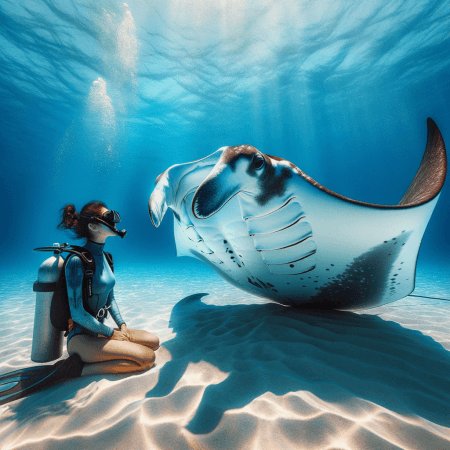
Manta rays are more than just beautiful; they’re also quite intelligent, capable of recognizing themselves in mirrors. Imagine sharing a moment with a creature that can mirror your curiosity! However, interacting with them requires knowledge and caution. Just like meeting anyone new, it’s important to understand their behavior and environment. So, grab a cup of coffee, and let’s explore the ins and outs of these incredible ocean dwellers.
Understanding Manta Rays: A Brief Overview
Manta rays belong to the family Mobulidae and can be divided into two species: the giant manta ray and the reef manta ray. The giant manta can grow up to 29 feet across, while the reef manta is smaller, averaging around 11 feet. Both species thrive in warm waters, often seen near coral reefs, which serve as feeding grounds.
These creatures are filter feeders, primarily consuming tiny organisms like plankton and small fish. They use their wide mouths to filter water and capture food as they glide gracefully through the sea. Imagine them as the gentle vacuum cleaners of the ocean, cruising through the water, filtering out their meals. Their peaceful nature is one reason many divers and snorkelers are drawn to the idea of swimming with them.
The Safety of Swimming with Manta Rays
So, can you swim with these gentle giants? Yes, but with careful consideration. Manta rays *are not aggressive* and typically don’t pose a threat to humans. They show curiosity towards divers but won’t approach unless they feel comfortable. Just like any animal encounter, it’s essential to respect their space and avoid sudden movements or loud noises.
Here are some tips to ensure safe interaction during your swim:
- Keep your distance: Stay at least 3 meters away to avoid startling them.
- Avoid touching: Manta rays have sensitive skin. Touching them can cause stress.
- Stay calm: Move slowly and quietly to avoid scaring them off.
Manta ray encounters are often more about watching than touching. Honestly, just observing their serene movements can be a magical experience.
Best Practices for Safe Interaction
If you’re planning to dive or snorkel with manta rays, it’s important to follow a few best practices. Having some guidelines can enhance your experience while keeping both you and the manta ray safe.
First, always join a reputable tour with experienced guides. These professionals are knowledgeable about manta ray behavior and can lead you through the safest ways to interact. They’ll ensure you’re at the right spots during feeding times, giving you the best chance to see these beauties up close.
Next, familiarize yourself with local regulations regarding manta ray interactions. In many places, there are guidelines in place to protect these creatures. Following these rules not only keeps you safe but helps preserve their habitats. Always prioritize sustainability over excitement.
Conservation Efforts and Their Importance
As more people become interested in manta ray interactions, conservation efforts are crucial. Manta rays are classified as vulnerable due to threats from fishing, habitat loss, and climate change. When you choose to swim with them, you’re not just enjoying a breath-taking experience—you’re also supporting conservation efforts.
Many regions have established marine protected areas (MPAs) where these rays can thrive. By participating in responsible ecotourism, you contribute to the conservation of their habitats. It’s a win-win! You get to create unforgettable memories, and they get a little more peace to live their lives.
What to Expect During a Manta Ray Encounter
You might be wondering what your experience will be like when swimming with manta rays. Typically, tours start with a briefing session where the guides explain what to expect, including safety guidelines and behavior of the rays.
Once you’re in the water, the experience can feel almost surreal. Manta rays glide gracefully, their enormous wings unfurling around you. Many divers describe the feeling as being in a scene out of a nature documentary. Honestly, it’s like swimming with a friendly cloud!
Again, keeping a respectful distance is key. Allow them to approach you if they want to, and don’t be tempted to chase or corner them. They’ll often swim in circles, showcasing their incredible wingspan and grace.
Combining Adventure with Respect
Engaging with manta rays can be a life-changing experience. It’s one of those rare moments when you can feel truly connected to nature. However, respect and safety should always be your top priorities.
Think of your encounter as a dance—you should let the manta ray lead. Follow the rhythm of their movements, and don’t forget to breathe! It can be easy to get caught up in snapping that perfect photo, but remember that you’re a guest in their world.
In closing, interacting with manta rays safely is not just about enjoying their presence but also about fostering a deeper understanding and respect for the ocean. By following the guidelines and embracing the experience, you can create beautiful memories of these gentle giants while contributing to their preservation. Happy swimming!

